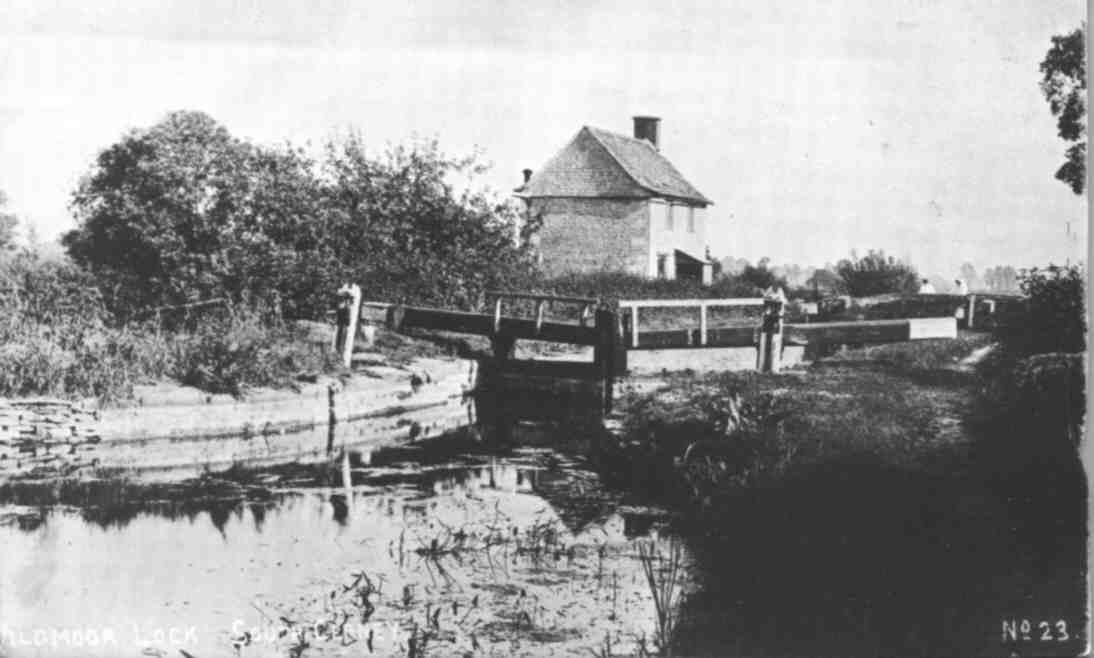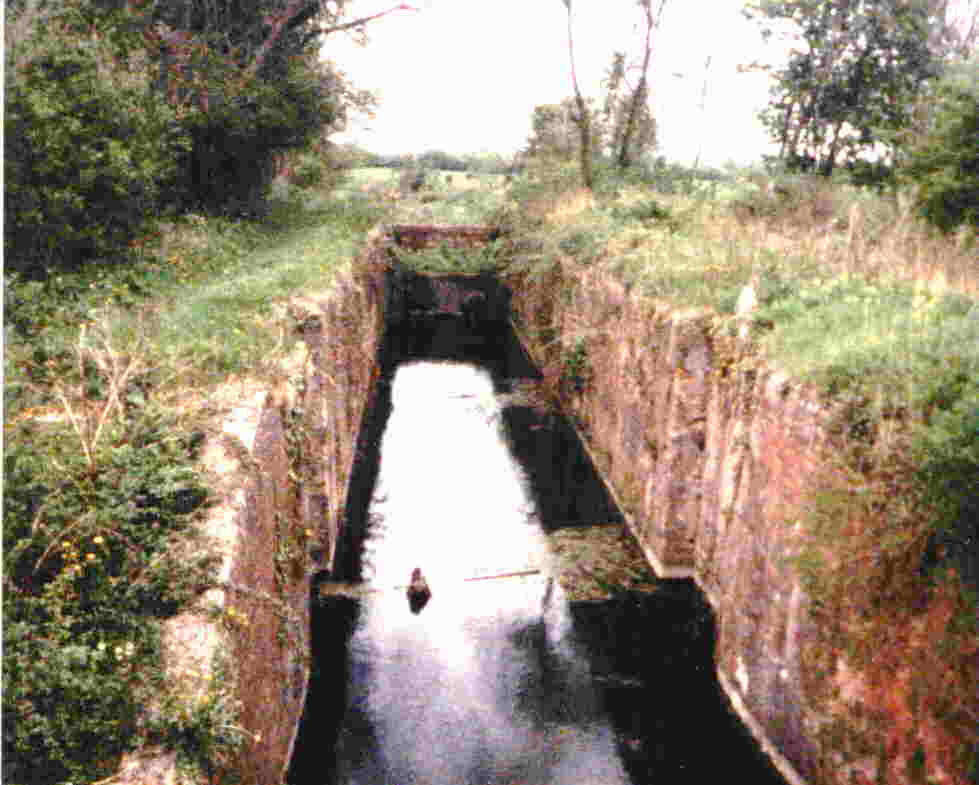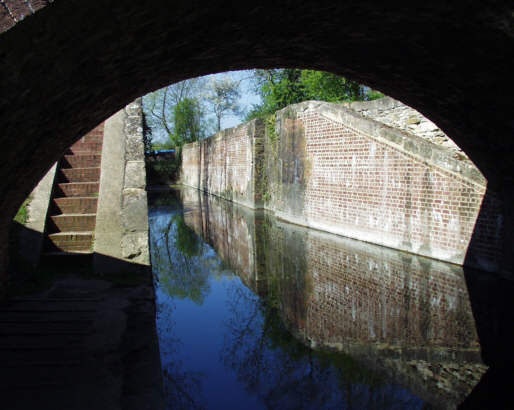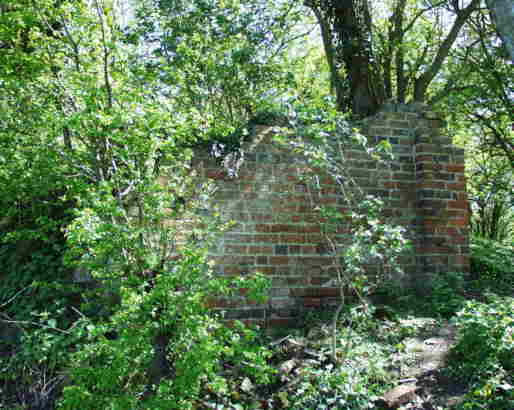Wildmoorway
picture gallery
The Wildmoorway or Wilmoreway Locks are located in a remote
section of the canal just east of South Cerney. Even today there is a
feeling of isolation between the upper and lower locks and what is left
of the moor is a SSSI (Site of Special Scientific Interest). In the spring
wild flowers abound - in the winter, it can be a cold and bleak place.

Wildmoorway Lower Lock
in about 1907.
This lock had a large fall of about 11ft which, after the insertion
of Boxwell Spring Lock and consequential reduction in the fall of Wildmoorway
Upper Lock from 11ft to only 7ft 6ins, needed a side-pond to conserve
water supplies.
The side-pond was built in 1831 and its operation was, perhaps
uniquely, semi automatic. The iron connecting pipe between the lock and
the side-pond had an iron hinged valve at each end and the
non-hinged side of the valve was connected to a rack and pinion
mechanism via a hinged connecting rod. As one valve was pulled open by
the use of the rack, the hinged connecting rod allowed the other
to open if there was positive water pressure behind the valve. This simplified
its operation but nevertheless, the Thames & Severn Canal Company
decided to relocate the lock keeper from Cerney Wick Lock to a new lock cottage
adjacent to Wildmoorway Lower Lock. The Edwardian ladies dressed
in white just visible on the bridge are sisters and the nearby Sister's Farm
is named after them.
According to Herbert Frankin, the occupant of Sisters Farm and
owner of the canal here, both the Lock Cottage and the Lock and its gates
were in good condition well into the 1950s. He also mentioned the existence
of some kind of water control structure where the Spine Road is now sited
which [raised] water from the feeder into the canal - how this was supposed
to work is a mystery.
The building of the Spine Road caused a blockage across the canal
which resulted in the length immediately downstream of Wildmoorway Lower
Lock holding water whilst the removal of a section of the towpath bridge
on the downstream side of the Spine Road effectively drained the length
down to Cerney Wick Lock in all but the wettest weather.
Even in the 1980s, the wooden frames for the ground paddle gear at
the head of both of the Wildmoorway locks were still in place as were
substantial remains of the lower lock gates - particularly below water
level. However, much of the lock cottage had, by then and unlike
its twin at Eysey, fallen down.

Wildmoorway Lower Lock in about 1983 after
clearance but prior to major restoration
The Cotswold Canals Trust (then known as the Stroudwater, Thames and
Severn Canal Trust) gained permission and worked on this length of canal
initially in the early 1980s. Work included clearing the canal bed of overgrowth
including willow saplings and the insertion of stop planks to allow the
pound between the two Wildmoorway Locks to fill up when water supply permitted.
What is not clear from the picture is just how bad the offside main lock
chamber wall was.

Wildmoorway Lower Lock in 2002 after
significant restoration
Later on, amidst growing concern about the poor state of the bridge
at the tail of the lower lock, the Trust working with the Waterway Recovery
Group set up a Dig Deep project to carry out major repairs to the lock
chamber and the bridge. This work was completed in the late 1990s leaving
some work still to be done on the towpath wall and re-gating.

Fragmentary remains of Humpback Bridge
Wildmoorway Upper Lock is located about a third of a mile upstream (towards
the Severn) of the lower one. It was also sometimes known as Humpback Lock
after the humpback accommodation bridge which used to be located some distance
below it. (This bridge was largely demolished by its owner after a potentially
serious accident occurred there when it was being crossed by a farm vehicle
- strangely no alternative means of vehicle access was provided. A small
portion of the towpath side abutment can still be seen.)

Wildmoorway Upper Lock
The Upper Lock has received little attention apart from the removal of
a couple of large trees which were beginning to damage the structure.
The towpath wall is poor towards the top whilst the offside wall is, for
the most part, much better. This is the opposite of the former condition
of the Lower Lock There is some concern that the digging activities
by badgers in the past may have damaged the overflow weir culvert which is
located under the towpath.
The upper gates have, at some time in the distant past, been replaced
by a brick wall in the shape of the original lock gates. An attempt was
made to re-water the pound between here and Boxwell Spring Lock by inserting
paving slabs in the original wooden paddle guides. This revealed significant
leakage towards the far end of the pound in the area of the springs - an
area that had been repuddled presumably to overcome the same problem early
in the 20th century restoration work. It was only possible to refill the
pound full during a very wet spell of weather and this generated impressive
fountains in the field below the canal embankment where the lower Boxwell
Springs used to flow before the water table was significantly dropped in
the 1930s due to water extraction at Latton Pumping Station.
Wildmoorway Gallery
Back to T&S Canal Page
Copyright © Ken Burgin 2002




